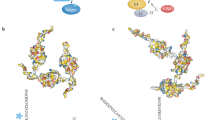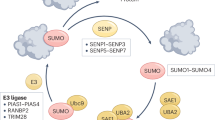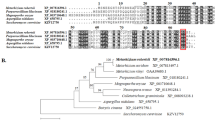Abstract
Since the discovery of post-translational modification (PTM) by the small ubiquitin-related modifiers (SUMOs), a multitude of proteins have been described to be reversibly modified, resulting in the alteration of several cellular pathways. Interestingly, various pathogens gain access to this modification system, although the molecular mechanisms and functional consequences are barely understood. We show here that the adenoviral oncoprotein E1B-55K is a substrate of the SUMO conjugation system, which is directly linked to its C-terminal phosphorylation. This regulative connection is indispensable for modulation of the tumor suppressor p53/chromatin-remodeling factor Daxx by E1B-55K and, consequently, its oncogenic potential in primary mammalian cells. In virus infection, E1B-55K PTMs are necessary for localization to viral transcription/replication sites. Furthermore, we identify the E2 enzyme Ubc9 as an interaction partner of E1B-55K, providing a possible molecular explanation for SUMO-dependent modulation of cellular target proteins. In conclusion, these results for the first time provide evidence how E1B-55K PTMs are regulated and subsequently facilitate exploitation of the host cell SUMOylation machinery.
This is a preview of subscription content, access via your institution
Access options
Subscribe to this journal
Receive 50 print issues and online access
$259.00 per year
only $5.18 per issue
Buy this article
- Purchase on SpringerLink
- Instant access to full article PDF
Prices may be subject to local taxes which are calculated during checkout







Similar content being viewed by others
References
Kerscher O, Felberbaum R, Hochstrasser M . Modification of proteins by ubiquitin and ubiquitin-like proteins. Annu Rev Cell Dev Biol 2006; 22: 159–180.
Bossis G, Melchior F . SUMO: regulating the regulator. Cell Div 2006; 1: 13.
Gareau JR, Lima CD . The SUMO pathway: emerging mechanisms that shape specificity, conjugation and recognition. Nat Rev Mol Cell Biol 11: 861–871.
Geiss-Friedlander R, Melchior F . Concepts in sumoylation: a decade on. Nat Rev Mol Cell Biol 2007; 8: 947–956.
Hannoun Z, Greenhough S, Jaffray E, Hay RT, Hay DC . Post-translational modification by SUMO. Toxicology 278: 288–293.
Hay RT . SUMO: a history of modification. Mol Cell. 2005; 18: 1–12.
Johnson ES . Protein modification by SUMO. Annu Rev Biochem 2004; 73: 355–382.
Melchior F . SUMO - nonclassical ubiquitin. Annu Rev Cell Biol 2000; 16: 591–626.
Müller S, Hoege C, Pyrowolakis G, Jentsch S . SUMO, ubiquitin's mysterious cousins. Nature 2001; 2: 202–210.
Seeler JS, Dejean A . Nuclear and unclear functions of SUMO. Nat Rev Mol Cell Biol 2003; 4: 690–699.
Ullrich HD . The SUMO system: an overview. Methods Mol Biol 2009; 497: 3–16.
Wilkinson KA, Henley JM . Mechanisms, regulation and consequences of protein SUMOylation. Biochem J 2010; 428: 133–145.
Berk A . Adenoviridae: The Viruses and Their Replication 5th edn. Raven Press, New York, NY, 2007.
Berk AJ . Recent lessons in gene expression, cell cycle control, and cell biology from adenovirus. Oncogene 2005; 24: 7673–7685.
Weitzman MD, Ornelles DA . Inactivating intracellular antiviral responses during adenovirus infection. Oncogene 2005; 24: 7686–7696.
White E . Regulation of the cell cycle and apoptosis by the oncogenes of adenovirus. Oncogene 2001; 20: 7836–7846.
Dobner T, Kzhyshkowska J . Nuclear export of adenovirus RNA. Curr Top Microbiol Immunol 2001; 259: 25–54.
Flint J, Gonzalez R . Regulation of mRNA production by the adenoviral E1B 55-kDa and E4 Orf6 proteins. Curr Top Microbiol Immunol 2003; 272: 287–330.
Boggio R, Chiocca S . Viruses and sumoylation: recent highlights. Curr Opin Microbiol. 2006; 9: 430–436.
Wilson VG, Rangasamy D . Viral interaction with the host cell sumoylation system. Virus Res 2001; 81: 17–27.
Wimmer P, Schreiner S, Dobner T . Human pathogens and the host cell SUMOylation system. J Virol 2012; 86: 642–654.
Endter C, Hartl B, Spruss T, Hauber J, Dobner T . Blockage of CRM1-dependent nuclear export of the adenovirus type 5 early region 1B 55-kDa protein augments oncogenic transformation of primary rat cells. Oncogene 2005; 24: 55–64.
Endter C, Kzhyshkowska J, Stauber R, Dobner T . SUMO-1 modification required for transformation by adenovirus type 5 early region 1B 55-kDa oncoprotein. Proc Natl Acad Sci USA 2001; 98: 11312–11317.
Kindsmüller K, Groitl P, Härtl B, Blanchette P, Hauber J, Dobner T . Intranuclear targeting and nuclear export of the adenovirus E1B-55K protein are regulated by SUMO1 conjugation. Proc Natl Acad Sci USA 2007; 104: 6684–6689.
Dosch T, Horn F, Schneider G, Krätzer F, Dobner T, Hauber J et al. The adenovirus type 5 E1B-55K oncoprotein actively shuttles in virus-infected cells, whereas transport of E4orf6 is mediated by a CRM1 independent-mechanism. J Virol 2001; 75: 5677–5683.
Krätzer F, Rosorius O, Heger P, Hirschmann N, Dobner T, Hauber J et al. The adenovirus type 5 E1B-55k oncoprotein is a highly active shuttle protein and shuttling is independent of E4orf6, p53 and Mdm2. Oncogene 2000; 19: 850–857.
Teodoro JG, Branton PE . Regulation of p53-dependent apoptosis, transcriptional repression, and cell transformation by phosphorylation of the 55-kilodalton E1B protein of human adenovirus type 5. J Virol 1997; 71: 3620–3627.
Teodoro JG, Halliday T, Whalen SG, Takayesu D, Graham FL, Branton PE . Phosphorylation at the carboxy terminus of the 55-kilodalton adenovirus type 5 E1B protein regulates transforming activity. J Virol 1994; 68: 776–786.
Ching W, Dobner T, Koyuncu E . The human Adenovirus type 5 E1B-55K protein is phosphorylated by protein kinase CK2. J Virol 2011.
Endter C, Kzhyshkowska J, Stauber R, Dobner T . SUMO-1 modification required for transformation by adenovirus type 5 early region 1B 55-kDa oncoprotein. Proceedings of the National Academy of Sciences of the United States of America 2001; 98: 11312–11317.
Schwartz RA, Lakdawala SS, Eshleman HD, Russel MR, Carson CT, Weitzman MD . Distinct requirements of Adenovirus E1b55K protein for degradation of cellular substrates. J Virol 2008; 82: 9043–9055.
Li X, Lin HH, Chen H, Xu X, Shih HM, Ann DK . SUMOylation of the transcriptional co-repressor KAP1 is regulated by the serine and threonine phosphatase PP1. Sci Signal 2010; 3: ra32.
Tan JA, Song J, Chen Y, Durrin LK . Phosphorylation-dependent interaction of SATB1 and PIAS1 directs SUMO-regulated caspase cleavage of SATB1. Mol Cell Biol 2010; 30: 2823–2835.
Stehmeier P, Müller S . Phospho-regulated SUMO interaction modules connect the SUMO system to CK2 signaling. Mol cell 2009; 33: 400–409.
Müller S, Dobner T . The adenovirus E1B-55K oncoprotein induces SUMO modification of p53. Cell Cycle 2008; 7: 754–758.
Pennella MA, Liu Y, Woo JL, Kim CA, Berk AJ . Adenovirus E1B 55-kilodalton protein is a p53-SUMO1 E3 ligase that represses p53 and stimulates its nuclear export through interactions with promyelocytic leukemia nuclear bodies. J Virol 2010; 84: 12210–12225.
Wimmer P, Schreiner S, Everett R, Sirma H, Groitl P, Dobner T . SUMO modification of E1B-55K oncoprotein regulates isoform-specific binding to the tumour suppressor protein PML. Oncogene 2010; 29: 5511–5522.
Schreiner S, Wimmer P, Groitl P, Chen SY, Blanchette P, Branton PE et al. Adenovirus type 5 early region 1B 55K oncoprotein dependent degradation of cellular factor Daxx is required for efficient transformation of primary rodent cells. J Virol 2011; 85: 8752–8765.
Zhu J, Zhu S, Guzzo CM, Ellis NA, Sung KS, Choi CY et al. Small ubiquitin-related modifier (SUMO) binding determines substrate recognition and paralog-selective SUMO modification. J Biol Chem 2008; 283: 29405–29415.
Mukhopadhyay D, Dasso M . Modification in reverse: the SUMO proteases. Trends Biochem Sci 2007; 32: 286–295.
Kindsmüller K, Groitl P, Hartl B, Blanchette P, Hauber J, Dobner T . Intranuclear targeting and nuclear export of the adenovirus E1B-55K protein are regulated by SUMO1 conjugation. Proceedings of the National Academy of Sciences of the United States of America 2007; 104: 6684–6689.
Kao CC, Yew PR, Berk AJ . Domains required for in vitro association between the cellular p53 and the adenovirus 2 E1B 55K proteins. Virology 1990; 179: 806–814.
Sarnow P, Ho YS, Williams J, Levine AJ . Adenovirus E1b-58kd tumor antigen and SV40 large tumor antigen are physically associated with the same 54 kd cellular protein in transformed cells. Cell 1982; 28: 387–394.
Yew PR, Liu X, Berk AJ . Adenovirus E1B oncoprotein tethers a transcriptional repression domain to p53. Genes Dev 1994; 8: 190–202.
Martin ME, Berk AJ . Adenovirus E1B 55K represses p53 activation in vitro. J Virol 1998; 72: 3146–3154.
Martin ME, Berk AJ . Corepressor required for adenovirus E1B 55,000-molecular-weight protein repression of basal transcription. Mol Cell Biol 1999; 19: 3403–3414.
Härtl B, Zeller T, Blanchette P, Kremmer E, Dobner T . Adenovirus type 5 early region 1B 55-kDa oncoprotein can promote cell transformation by a mechanism independent from blocking p53-activated transcription. Oncogene 2008; 27: 3673–3684.
Sieber T, Dobner T . Adenovirus type 5 early region 1B 156R protein promotes cell transformation independently of repression of p53-stimulated transcription. J Virol 2007; 81: 95–105.
Schreiner S, Wimmer P, Sirma H, Everett RD, Blanchette P, Groitl P et al. Proteasome-dependent degradation of Daxx by the viral E1B-55K protein in human adenovirus-infected cells. J Virol 2010; 84: 7029–7038.
Querido E, Blanchette P, Yan Q, Kamura T, Morrison M, Boivin D et al. Degradation of p53 by adenovirus E4orf6 and E1B55K proteins occurs via a novel mechanism involving a Cullin-containing complex. Genes Dev 2001; 15: 3104–3117.
Gonzalez RA, Flint SJ . Effects of mutations in the adenoviral E1B 55-kilodalton protein coding sequence on viral late mRNA metabolism. J Virol 2002; 76: 4507–4519.
Blackford AN, Grand RJ . Adenovirus E1B 55-kilodalton protein: multiple roles in viral infection and cell transformation. J Virol 2009; 83: 4000–4012.
Ornelles DA, Shenk T . Localization of the adenovirus early region 1B 55-kilodalton protein during lytic infection: association with nuclear viral inclusions requires the early region 4 34-kilodalton protein. J Virol 1991; 65: 424–429.
Lethbridge KJ, Scott GE, Leppard KN . Nuclear matrix localization and SUMO-1 modification of adenovirus type 5 E1b 55K protein are controlled by E4 Orf6 protein. J Gen Virol 2003; 84: 259–268.
Leppard KN . Regulated RNA processing and RNA transport during adenovirus infection. Semin Virol 1998; 8: 301–307.
Leppard KN . Selective effects on adenovirus late gene expression of deleting the E1b 55K protein. J Gen Virol 1993; 74: 575–582.
Leppard KN, Shenk T . The adenovirus E1B 55 kd protein influences mRNA transport via an intranuclear effect on RNA metabolism. EMBO J 1989; 8: 2329–2336.
Blanchette P, Kindsmuller K, Groitl P, Dallaire F, Speiseder T, Branton PE et al. Control of mRNA export by adenovirus E4orf6 and E1B55K proteins during productive infection requires E4orf6 ubiquitin ligase activity. J Virol 2008; 82: 2642–2651.
Woo JL, Berk AJ . Adenovirus ubiquitin-protein ligase stimulates viral late mRNA nuclear export. J Virol 2007; 81: 575–587.
Yousef AF, Fonseca GJ, Pelka P, Ablack JN, Walsh C, Dick FA et al. Identification of a molecular recognition feature in the E1A oncoprotein that binds the SUMO conjugase UBC9 and likely interferes with polySUMOylation. Oncogene 2010; 29: 4693–4704.
Soria C, Estermann FE, Espantman KC, O'Shea CC . Heterochromatin silencing of p53 target genes by a small viral protein. Nature 2010; 466: 1076–1081.
Stracker TH, Carson CT, Weitzman MD . Adenovirus oncoproteins inactivate the Mre11 Rad50 NBS1 DNA repair complex. Nature 2002; 418: 348–352.
Baker A, Rohleder KJ, Hanakahi LA, Ketner G . Adenovirus E4 34k and E1b 55k oncoproteins target host DNA ligase IV for proteasomal degradation. J Virol 2007; 81: 7034–7040.
Dallaire F, Blanchette P, Groitl P, Dobner T, Branton PE . Identification of integrin alpha3 as a new substrate of the adenovirus E4orf6/E1B 55-kilodalton E3 ubiquitin ligase complex. J Virol 2009; 83: 5329–5338.
Wojcik C, DeMartino GN . Intracellular localization of proteasomes. Int J Biochem Cell Biol 2003; 35: 579–589.
Latonen L . Nucleolar aggresomes as counterparts of cytoplasmic aggresomes in proteotoxic stress. Proteasome inhibitors induce nuclear ribonucleoprotein inclusions that accumulate several key factors of neurodegenerative diseases and cancer. BioEssays: News and Reviews in Molecular, Cellular and Developmental Biology 2011; 33: 386–395.
Liu Y, Shevchenko A, Shevchenko A, Berk AJ . Adenovirus exploits the cellular aggresome response to accelerate inactivation of the MRN complex. J Virol 2005; 79: 14004–14016.
Yew PR, Berk AJ . Inhibition of p53 transactivation required for transformation by adenovirus early 1B protein. Nature 1992; 357: 82–85.
Souquere-Besse S, Pichard E, Filhol O, Legrand V, Rosa-Calatrava M, Hovanessian AG et al. Adenovirus infection targets the cellular protein kinase CK2 and RNA-activated protein kinase (PKR) into viral inclusions of the cell nucleus. Microsc Res Tech 2002; 56: 465–478.
Leppard KN, Everett RD . The adenovirus type 5 E1b 55K and E4 Orf3 proteins associate in infected cells and affect ND10 components. J Gen Virol 1999; 80 (Part 4): 997–1008.
Mohideen F, Capili AD, Bilimoria PM, Yamada T, Bonni A, Lima CD . A molecular basis for phosphorylation-dependent SUMO conjugation by the E2 UBC9. Nat Struct Mol Biol 2009; 16: 945–952.
Escobar-Cabrera E, Okon M, Lau DK, Dart CF, Bonvin AM, McIntosh LP . Characterizing the N- and C-terminal Small ubiquitin-like modifier (SUMO)-interacting motifs of the scaffold protein DAXX. J Bioll Chem 2011; 286: 19816–19829.
Santiago A, Godsey AC, Hossain J, Zhao LY, Liao D . Identification of two independent SUMO-interacting motifs in Daxx: evolutionary conservation from Drosophila to humans and their biochemical functions. Cell Cycle 2009; 8: 76–87.
Haas AL . Structural insights into early events in the conjugation of ubiquitin and ubiquitin-like proteins. Mol cell 2007; 27: 174–175.
Yang SH, Galanis A, Witty J, Sharrocks AD . An extended consensus motif enhances the specificity of substrate modification by SUMO. Embo J 2006; 25: 5083–5093.
Rangasamy D, Wilson VG . Bovine papillomavirus E1 protein is sumoylated by the host cell Ubc9 protein. J Biol Chem 2000; 275: 30487–30495.
Mitsudomi T, Steinberg SM, Nau MM, Carbone D, D'Amico D, Bodner HK et al. p53 gene mutations in non-small-lung cell cancer cell lines and their correlation with the presence of ras mutations and clinical features. Oncogene 1992; 7: 171–180.
Graham FL, Smiley J, Russel WC, Nairn R . Characteristics of a human cell line transformed by DNA from human adenovirus type 5. J Gen Virol 1977; 36: 59–72.
Nevels M, Dobner T . Determination of the transforming activities of adenovirus oncogenes. In: Wold WS, Tollefson AE (eds) Adenovirus Methods and Protocols 2nd edn. Humana Press Inc., Totowa, NJ, 2006, pp 187–195.
Rubenwolf S, Schütt H, Nevels M, Wolf H, Dobner T . Structural analysis of the adenovirus type 5 E1B 55-kilodalton-E4orf6 protein complex. J Virol 1997; 71: 1115–1123.
Dobner T, Horikoshi N, Rubenwolf S, Shenk T . Blockage by adenovirus E4orf6 of transcriptional activation by the p53 tumor suppressor. Science 1996; 272: 1470–1473.
Gostissa M, Hengstermann A, Fogal V, Sandy P, Schwarz SE, Scheffner M et al. Activation of p53 by conjugation to the ubiquitin-like protein SUMO-1. EMBO J 1999; 18: 6462–6471.
Okamoto K, Beach D . Cyclin G is a transcriptional target of the p53 tumor suppressor protein. EMBO J 1994; 13: 4816–4822.
Logan J, Pilder S, Shenk T . Functional analysis of adenovirus type 5 early region 1B. Cancer Cells 1984; 2: 527–532.
Groitl P, Dobner T . Construction of adenovirus type 5 early region 1 and 4 virus mutants. Methods Mol Med 2007; 130: 29–39.
Groitl P, Zeller T, Dobner T . Construction of adenovirus mutants by direct cloning. In: Wold WS (ed) Adenovirus Methods and Protocols. Humana Press Inc., Totowa, NJ, 2005.
Kindsmüller K, Schreiner S, Leinenkugel F, Groitl P, Kremmer E, Dobner T . A 49-kilodalton isoform of the adenovirus type 5 early region 1B 55-kilodalton protein is sufficient to support virus replication. J Virol 2009; 83: 9045–9056.
Sarnow P, Sullivan CA, Levine AJ . A monoclonal antibody detecting the adenovirus type 5-E1b-58Kd tumor antigen: characterization of the E1b-58Kd tumor antigen in adenovirus-infected and -transformed cells. Virology 1982; 120: 510–517.
Boivin D, Morrison MR, Marcellus RC, Querido E, Branton PE . Analysis of synthesis, stability, phosphorylation, and interacting polypeptides of the 34-kilodalton product of open reading frame 6 of the early region 4 protein of human adenovirus type 5. J Virol 1999; 73: 1245–1253.
Reich NC, Sarnow P, Duprey E, Levine AJ . Monoclonal antibodies which recognize native and denatured forms of the adenovirus DNA-binding protein. Virology 1983; 128: 480–484.
Matunis MJ, Coutavas E, Blobel G . A novel ubiquitin-like modification modulates the partitioning of the Ran-GTPase-activating protein RanGAP1 between the cytosol and the nuclear pore complex. J Cell Biol 1996; 135 (6 Part 1): 1457–1470.
Zhang XD, Goeres J, Zhang H, Yen TJ, Porter AC, Matunis MJ . SUMO-2/3 modification and binding regulate the association of CENP-E with kinetochores and progression through mitosis. Mol cell 2008; 29: 729–741.
Acknowledgements
We apologize for all the important publications and excellent reviews we could not cite/refer to due to space limitations. The Heinrich–Pette–Institute is supported by the ‘Freie und Hansestadt Hamburg’ and the ‘Bundesministerium für Gesundheit’. TD was supported by a grant from the Wilhelm Sander-Stiftung, Munich, Germany. PEB and PB were supported through grants from the Canadian Institutes of Health Research.
Author information
Authors and Affiliations
Corresponding author
Ethics declarations
Competing interests
The authors declare no conflict of interest.
Additional information
Supplementary Information accompanies the paper on the Oncogene website
Supplementary information
Rights and permissions
About this article
Cite this article
Wimmer, P., Blanchette, P., Schreiner, S. et al. Cross-talk between phosphorylation and SUMOylation regulates transforming activities of an adenoviral oncoprotein. Oncogene 32, 1626–1637 (2013). https://doi.org/10.1038/onc.2012.187
Received:
Revised:
Accepted:
Published:
Issue date:
DOI: https://doi.org/10.1038/onc.2012.187
Keywords
This article is cited by
-
Ixovex-1, a novel oncolytic E1B-mutated adenovirus
Cancer Gene Therapy (2022)
-
PML isoforms IV and V contribute to adenovirus-mediated oncogenic transformation by functionally inhibiting the tumor-suppressor p53
Oncogene (2016)
-
Automatic detection and measurement of viral replication compartments by ellipse adjustment
Scientific Reports (2016)
-
Sp100A is a tumor suppressor that activates p53-dependent transcription and counteracts E1A/E1B-55K-mediated transformation
Oncogene (2016)
-
Interplay between viruses and host sumoylation pathways
Nature Reviews Microbiology (2013)



